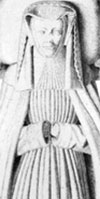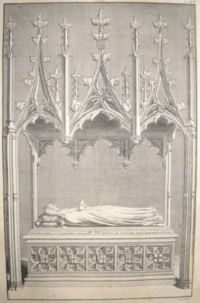Philippa Mohun facts for kids
Quick facts for kids Philippa de Mohun |
|
|---|---|
| Duchess of York | |

Effigy in Chapel of St Nicholas, Westminster Abbey, of Philippa de Mohun (d.1431), Duchess of York. Detail from etching of drawing by Charles Stothard (1786-1821), published in The Monumental Effigies of Great Britain (London, 1817).
|
|
| Born | c. 1367 |
| Died | 17 July 1431 Carisbrooke Castle, Isle of Wight |
| Burial | Westminster Abbey, London |
| Spouse | Walter Fitzwalter, 3rd Baron Fitzwalter Sir John Golafre Edward of Norwich, 2nd Duke of York |
| Father | John de Mohun, 2nd Baron Mohun |
| Mother | Joan Burghersh |
Philippa de Mohun (born around 1367 – died July 17, 1431) was an important lady in medieval England. She became the Duchess of York through her third marriage to Edward of Norwich, 2nd Duke of York. Edward was a grandson of King Edward III. After her husband died, Philippa also became the Lady of the Isle of Wight, a special title she held until her death.
Contents
Philippa's Family Background
Philippa's exact birth date is not known. She was the third daughter of John Mohun, 2nd Baron Mohun. Her father was a very important knight. He was one of the first members of the Order of the Garter, a special group of knights. Her mother was Joan Burghersh.
Inheriting Family Lands
Philippa's father did not have any sons. This meant that the family's main lands, including Dunster Castle in Somerset, would normally pass to his daughters. However, Philippa and her sisters did not inherit these lands. This was because her mother had sold the rights to the estates in 1374. The Luttrell family then owned Dunster Castle for many centuries. In 1976, it was given to the National Trust.
Philippa's Marriages and Titles
Philippa married three times during her life. Each marriage brought her new connections and titles.
First Marriage
Her first marriage was to Walter Fitzwalter, 4th Baron Fitzwalter. They had one son named Walter, who later became the 5th Baron Fitzwalter.
Second Marriage
Her second husband was Sir John Golafre. He was a knight who was favored by King Richard II. Sir John was known for his skill in jousting, which was a popular sport at the time. He was buried in Westminster Abbey after his death.
Third Marriage and Duchess of York
Philippa's third marriage was to Edward of Norwich, 2nd Duke of York. This marriage happened before October 7, 1398. Edward was a very important person. He was the eldest son of the first Duke of York and a grandson of King Edward III. When she married Edward, Philippa became the Duchess of York.
Edward died in 1415 at the Battle of Agincourt. After his death, Philippa was given the title of Lady of the Isle of Wight for the rest of her life. This meant she had control over the island.
Death and Burial in Westminster Abbey
Philippa died on July 17, 1431, at Carisbrooke Castle on the Isle of Wight. She was buried in Westminster Abbey in London. Her tomb and a statue of her can still be seen there today. Her second husband, Sir John Golafre, was also buried in Westminster Abbey. Philippa's mother was buried at Canterbury Cathedral.
Philippa's Monument in Westminster Abbey
Philippa's monument is in the Chapel of St Nicholas in Westminster Abbey. It features a stone statue of Philippa lying down. She is wearing a long cloak and a widow's hood. Her head rests on two cushions. The original paint on the statue has mostly worn away over time.
Family Shields on the Tomb
The tomb has seven shields carved into its sides. These shields show the coats of arms of her family and her husbands.
- Two shields show the Mohun family symbol.
- One shield shows the Royal arms of England.
- Another shield combines the Mohun and Burghersh family symbols, representing her parents.
- There are also shields combining the symbols of her first two husbands (FitzWalter and Golafre) with her own.
- Finally, a shield shows the Royal arms of England combined with Mohun, representing her marriage to the Duke of York.
In the past, the monument had a fancy wooden canopy above it, but this is now gone.
Philippa's Last Will
Before she died, Philippa made a will. In her will, she mentioned her son, Walter, Lord Fitzwalter. She also left money to different charities. She asked to be buried in Westminster Abbey. Her will also gave instructions for her funeral. She wanted prayers to be said and money to be given to poor people.


